
| Specs at a glance: Apple iPhone 5C | |
|---|---|
| Screen | 1136×640 4-inch (326PPI) touchscreen |
| OS | iOS 7 |
| CPU | 1.3GHz Apple A6 |
| RAM | 1GB DDR2 |
| GPU | Imagination Technologies SGX543MP3 |
| Storage | 16 or 32GB NAND flash |
| Networking | 802.11a/b/g/n, Bluetooth 4.0 |
| Ports | Lightning connector, headphone jack |
| Size | 4.90" × 2.33" × 0.35" (124.4 × 59.2 × 8.97 mm) |
| Weight | 4.65oz (132 g) |
| Battery | 1510mAh |
| Starting price | $99 with two-year contract, $549 unlocked |
| Other perks | Charger, earbuds, Lightning cable |
For several years now, Apple has sold three iPhones at once. There's the flagship, which has the fastest internals and shiny new hardware features like fingerprint sensors and Siri. There's the free-with-contract value option, the two-year-old phone that is showing definite signs of age but keeps kicking thanks to prompt software updates. And there's the middle child, the $99-with-contract phone that's just a year removed from being Apple's latest and greatest.
The iPhone 5C is Apple's effort to draw attention to that middle tier, which can otherwise be overshadowed by the newness of the flagship phone and the value proposition of the free-with-contract phone. For all practical intents and purposes, the 5C is last year's iPhone 5 poured into a series of colorful plastic shells rather than the aluminum-and-glass of the 5 and its true successor, the iPhone 5S. However, it's being marketed differently from any other mid-tier iPhone—if you want proof, note that the 5C (and not the 5S) is the first thing you've seen if you've been to Apple's home page since the September 10 announcement.
The iPhone 5S is absolutely the model that you should be looking at if you're a contented iPhone 4S customer looking to upgrade at the end of your two-year contract. The same goes if you're a power user fleeing another operating system, looking for the absolute best that Apple has to offer. The iPhone 5C is Apple's attempt to spruce up an existing product to appeal to new and more casual iPhone buyers, perhaps even to people who bought an iPhone 3GS or iPhone 4 for $99 or free-with-contract a couple of years ago and are ready to spring for something a little fancier now that it's time to upgrade. With that contextual information in mind, let's look at how the iPhone 5C fares in an increasingly crowded smartphone landscape.
Body, build quality, and screen
The short version: The iPhone 5C body is a little thicker and heavier than the 5 or 5S, but it feels very Lumia-esque in its sturdiness (watch out for scratches, though). The 4-inch screen is the exact same panel used in the iPhone 5, iPhone 5S, and fifth-generation iPod touch, which means great color, brightness, and viewing angles.
The long version: Given how inwardly similar the 5C is to last year's iPhone 5, the biggest question about it is how the new plastic shell holds up. This is Apple's first plastic iPhone since the iPhone 3GS back in 2009, and it's a definite departure after three straight years of glass-and-aluminum bodies.
My impressions from my initial hands-on time with the device still stand: the plastic of the 5C is much more in line with the rigid plastic bodies of the Lumia phones or the Moto X than with the thinner, more flimsy offerings we've seen from Samsung (and, more recently, LG). Aesthetically, the plastic shells give the 5C a different character than the staid black and silver shells of previous iPhones. While I personally am going to go for the iPhone with the most features and fastest internals, the colors will likely be a draw for more casual buyers (and it may even upsell those who walk into the store intending to get the free-with-contract iPhone 4S). The 5C tends toward lighter pastel shades rather than the darker and more saturated Lumia colors, but the overall effect is the same. Like the Lumias, every 5C comes out of the box with theming that complements the color of the rear shell.
While I expected a plastic iPhone to feel slightly lighter than the aluminum body of the iPhone 5 and 5S, the 5C is actually noticeably heavier if you're holding both phones at the same time. It's not a huge difference, but there's no mistaking it. The 5C is also thicker than the 5S by a noticeable but not staggering amount.
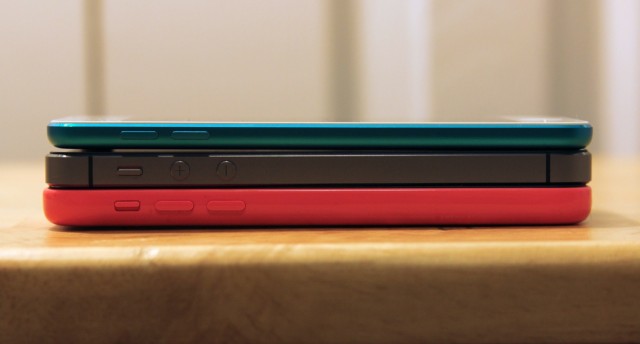
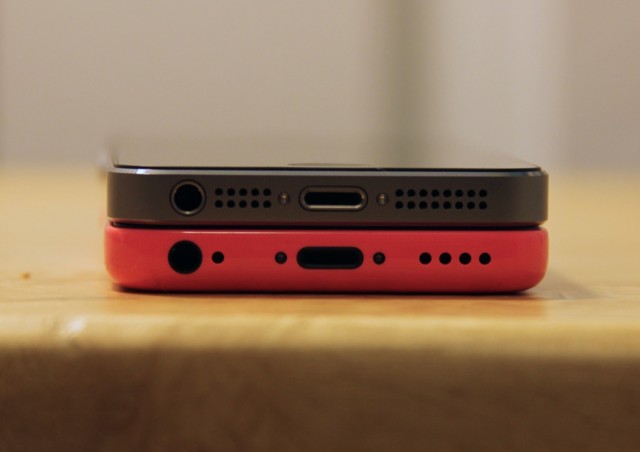
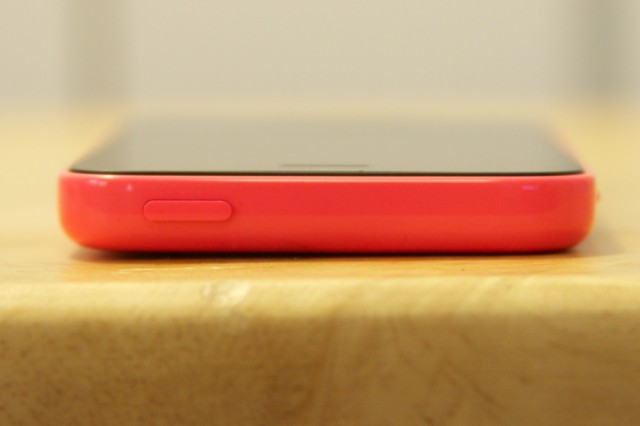

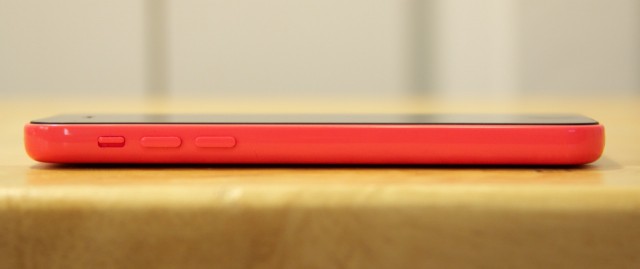
Now that we've gotten a look inside the 5C courtesy of iFixit, we know that the increase in weight and thickness is part of what makes the phone as sturdy as it is. Another contributing factor is that the shell is now one continuous piece of plastic rather than a couple of separate pieces as it was in the 3GS. By the time I had spent two years with that phone, the silver trim around the screen started to separate from the rear casing, and that sort of thing shouldn't be a concern in the 5C. The entire plastic surface is entirely smooth, seamless, and broken only by the phone's buttons and switches. Even the SIM tray sits perfectly flush with the side, where it protrudes slightly from the plastic body of the Moto X.

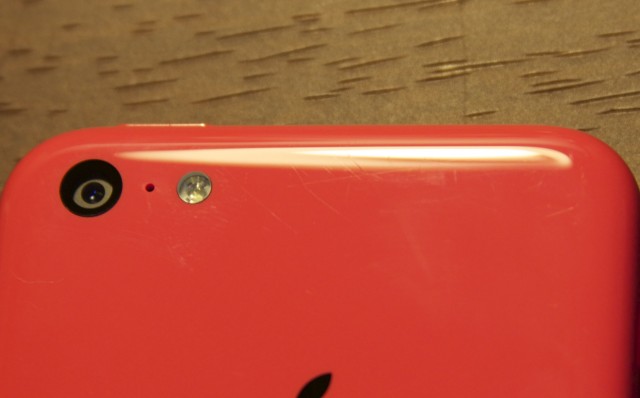
The phone feels reassuringly sturdy in your hand, but it's not perfect. One thing I noticed as I was actually carrying the phone around in a pocket or bag is that annoying little hairline scratches begin to assert themselves almost immediately. I scarcely had the phone 24 hours before a small lattice of scratches appeared on the back, and over months of usage you'll probably wear the shine off the shell unless you put it in a case. This is a problem we haven't noticed with the matte finish on the plastic Moto X.
Potential scratching issues aside, the plastic body of the 5C feels pretty good. Offering its mid-tier iPhone in different colors is a good way for Apple to diversify the iPhone lineup without actually having to change its strategy much. It gives customers something else to look at when they go to buy a phone, and it gets Apple more press than it would have gotten had it merely given the iPhone 5 a price cut. No one re-reviewed the iPhone 4S last year when it dropped to $99-with-contract, but as a "new" phone, the 5C has gotten almost as much press attention as the 5S. That's no coincidence.
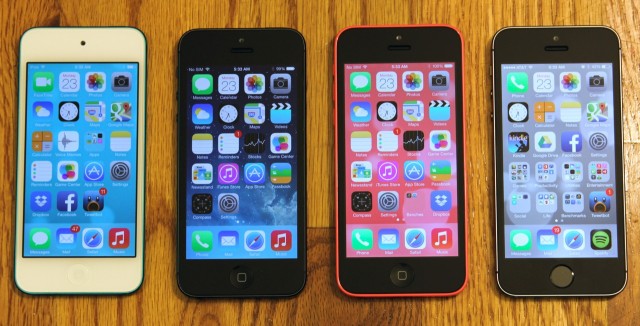
Thankfully, Apple isn't playing any cost-cutting games with the display on the 5C. Back in the days of the fourth-generation iPod touch, Apple gave that device a screen with the same resolution and density as the then-new iPhone 4 albeit with visibly inferior contrast and viewing angles. Now, it doesn't matter which device you buy—the iPhone 5C, iPhone 5S, iPhone 5, and fifth-generation iPod touch all appear to be using the same bright, vivid IPS panels. Viewing angles are good, and text and Retina-optimized images remain crisp.

At this point, the 4-inch, 1136×640, 326 PPI iPhone display has been thoroughly surpassed in both size and density by competing Android handsets. This is less true for the 5C than for the 5S, however—many offerings from the likes of Samsung and HTC in the $99-with-contract arena still use four-point-something-inch displays with 1280×720 resolutions. The 4.8-inch 306 PPI Galaxy S III and the 4.3-inch 340 PPI HTC One Mini don't outgun the 5C as thoroughly as the 5-inch 1080p monsters in the $199-with-contract arena outgun the 5S, for example. You can still get bigger screens at this price point if you go with an Android handset, but the comparison isn't quite so lopsided. If you're an Apple die-hard, the 4-inch display still feels more expansive than the 3.5-inch displays used on pre-iPhone 5 models.
Our thoughts on the size of the iPhone's display in the 5C and 5S are the same: it would be nice to see Apple give its displays a small size bump, since phones like the BlackBerry Z10 and Moto X have demonstrated that it's possible to make a phone with a larger screen that is comfortable to hold and operate with one hand. In the meantime, four inches remains a workable size, and if you don't hop between phones with regularity, you probably won't miss the extra space.
Camera
The camera in the iPhone 5C uses the exact same sensor, lens assembly, and single-LED flash as last year's iPhone 5. It's an 8MP shooter with backside illumination, 1.4µm pixels, an f/2.4 aperture, and a five-element lens. The phone will still take photos about as quickly as you can tap on the shutter button, but you don't pick up the Burst Mode or Slo-Mo features introduced with the iPhone 5S camera.
This camera is a known quantity at this point, but we took the 5C out with us while we did our iPhone 5S camera testing to get a sense of how well it performed a year after its introduction. We'll provide an abbreviated version of our comparisons from the iPhone 5S review below.
-
The iPhone 4S. In good light, the three iPhones often take shots that look very similar, differing only slightly in sharpness and color accuracy.
-
The iPhone 5C.
-
The iPhone 5S.
-
The Lumia 1020 produces a sharp, colorful shot.
-
The HTC One produces a soft and smeary image.
-
The Galaxy S 4 does well with detail here, unlike the HTC One.
-
The iPhone 4S does a decent job with detail (look at the fur), but the shot is a little too warm and renders this normally gray cat pretty brown.
-
The 5C improves the situation somewhat.
-
The 5S does a better job with color here. The shot is still just a little warm, but this is much closer to the cat's actual color.
-
The Galaxy S 4 is a little softer than the 5S, but the white balance is still a bit more accurate than the 4S or the 5C.
-
The HTC One takes us right back to brown and once again filters out noise a little too aggressively. It loses detail in the fur.
-
The Lumia 1020 did a truly excellent job with detail, but even when tweaking the white balance settings manually, the white balance was always way off. The Auto setting renders the entire shot a sort of yellow-green.
-
The iPhone 4S in low light. Things are very dark and indistinct.
-
The 5C at least improves things to the point that you can make out people.
-
The 5S takes the shot from the 5C, brightens it a bit, and cleans it up. It's not as good as the Lumia 1020, but it's not bad.
-
You can barely make out anything beyond the light bulbs in the S 4's picture.
-
You can see things in the HTC One's shot, but it has a tendency to make things red or purple when it's too dark.
-
Finally, the Lumia 1020, undisputed king of low-light smartphone camera shots.
The 5C camera still manages to outdo the cameras from previous iPhones and most Android phones even if it's no longer best-in-class. The 5S and recent Lumias will outdo it in low-light, but otherwise it's a good all-rounder that generally produces shots superior to what you'll get from most Android cameras. The 5C takes decent shots in most scenarios without requiring much thought from the user, which is all most smartphone cameras will ever be called upon to do.
reader comments
66